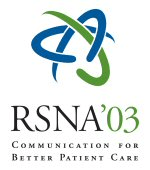Abstract:
HTML
Purpose: Total endoscopic coronary bypass (TECAB) and off-pump coronary bypass (OPCAB) surgery are innovative techniques requiring proof of immediate and short term patency of grafts in order to compete with conventional bypass surgery techniques. We sought to combine invasive and non-invasive imaging to reach optimal patient follow up.
Methods and Materials: In 17 patients with preoperative angina symptoms CCSC class II -III undergoing robotically assisted endoscopic bypass surgery (13) or off-pump surgery (4), we performed intraoperative coronary angiography. We used a mobile C-arm (OEC 9800)and recorded at least 2 angiographic standard projections. A total of 24 coronary bypass grafts (18 arterial grafts, 6 venous grafts) were imaged. 3 months after surgery, all patients underwent ECG gated 16 row multislice computertomography (MSCT) coronary angiography (Somatom Sensation 16, Siemens Medical Systems). Slice collimation was 0.75 mm, pitch given by individual heart rate. MSCT data were visualized in axial images, multiplanar reconstruction and volume rendering technique. Perioperative angiographic and MSCT data were subsequently evaluated by two experienced radiologists and cardiologists. Angiographic results were compared to clinical follow up and non-invasive stress testing (overall capacity, angina free interval, ECG signs of ischemia).
Results: All 24 bypass grafts could be visualized by perioperative angiography, 23 were judged patent. In one patient immediate surgical revision of a severe distal anastomotic bypass stenosis was required. 3 months postoperative clinical evaluation (no stress - related ischemic ECG signs, amelioration of angina classes CCSC II - III to classes 0 - I) showed excellent follow up status in all patients. In comparison to intraoperative angiography, MSCT imaging of arterial and venous grafts could be performed with high image quality. Proximal and distal graft anastomoses were shown to be patent in 100%. As a result from clinical and CT data, we did not record any indication for further invasive or non-invasive testing.
Conclusion: The use of perioperative coronary angiography, in combination with postoperative MSCT angiography, allows excellent imaging of immediate and short term results in innovative coronary bypass surgery procedures. Furthermore we found a good correlation of invasive and non-invasive bypass imaging to short term clinical follow up data. This approach may contribute to a higher quality control in total endoscopic and off-pump coronary surgery.
Questions about this event email: guy.friedrich@uklibk.ac.at
Friedrich MD, G,
Perioperative Coronary Angiography and Postoperative Multislice CT in Innovative Cardiac Surgery Procedures: An Approach to Higher Quality Control?. Radiological Society of North America 2003 Scientific Assembly and Annual Meeting, November 30 - December 5, 2003 ,Chicago IL.
http://archive.rsna.org/2003/3104087.html

